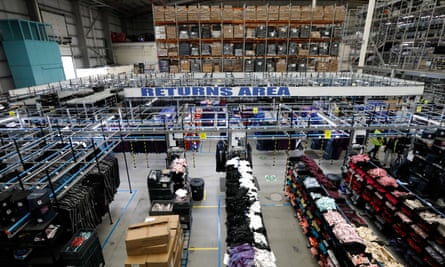“I bought and returned seven pairs of trainers during lockdown,” says Kate from Sussex. “I often order the same thing in two different sizes or two different colours and then return what I don’t like or what doesn’t fit. I never thought I would buy clothes online when the internet first started offering this, but I’m now very happy to.”
Kate is just one of millions of shoppers who, spurred on by the closure of physical stores during months of pandemic lockdowns, now regularly buys and returns goods online.
Up to half of clothing bought online is returned, depending on the retailer. Shoppers sent back an estimated £6.3bn of online purchases, including clothing, in 2020 and that figure is expected to rise by 9% by 2025, according to analysts at GlobalData.
Since the Covid lockdowns ended, returns have shot up as more fitted items – especially dresses – have come back into vogue, as shoppers are more likely to buy two products to make sure their purchase is suitable.
“With the cost-of-living crisis in play, many consumers will be more ruthless with their purchases, only keeping those that they are fully confident are suitable and good value,” says Patrick O’Brien, an analyst at GlobalData.
 View image in fullscreenMany shoppers buy items from sites such as Asos with the aim of returning the majority of them. Photograph: True Images/Alamy
View image in fullscreenMany shoppers buy items from sites such as Asos with the aim of returning the majority of them. Photograph: True Images/Alamy
More than 40% of shoppers now expect to return at least one item when they place an order – up from 30% pre-pandemic – according to the returns specialist ZigZag Global, as the chief executive, Al Gerrie, says people “got comfortable with online shopping” during lockdowns and some are reluctant to return to the high street.
He says trends such as wardrobing, where an item is worn out before being returned, and staging, where the item is tried on for pictures on social media before being sent back, are also on the rise. These trends are thought to account for less than one in 10 items sent back, but that still represents a significant volume.
Retail practices such as offering free delivery for orders over a certain value, free returns, subscription services which include free delivery such as Amazon Prime, flash sales and limited detail on fabrics or sizing, are also driving up the number of items flowing backwards and forwards between retailers, homes and the reprocessors handling returns, driving a blizzard of deliveries and huge amounts of waste.
Calculating the carbon emissions of returning goods is complicated, but an idea of the scale of the problem is indicated by research from logistics firm Optoro, which found that transporting returned goods in the US creates more than 15m tonnes of carbon dioxide emissions annually. That is the equivalent output of 3m cars.
With profits under pressure amid rising costs of transport, labour and raw materials, as well as increased concerns about environmental impact, retailers have begun serious attempts to discourage shoppers from sending items back.
 View image in fullscreenBoohoo has joined other retailers in charging shoppers to return goods bought online. Photograph: Pavlo Gonchar/SOPA Images/REX/Shutterstock
View image in fullscreenBoohoo has joined other retailers in charging shoppers to return goods bought online. Photograph: Pavlo Gonchar/SOPA Images/REX/Shutterstock
This week the online fashion specialist Boohoo joined Zara, Sports Direct and Next in charging to return goods bought online.
The change comes after Boohoo was forced to slash sales and profit expectations, and Asos issued its third profits warning in a year partly as a result of rising returns.
One distribution industry insider said many retailers wanted to follow suit, but were afraid it would hit sales at a difficult time. “It would be a brave retailer to introduce fines now,” he said.
The arrival of the Chinese fast-fashion giant Shein, combined with the reopening of high street stores, has pushed sales down by as much as 10% at some big online clothing retailers, according to some sources.
Other techniques include upgrading photography and using video so shoppers can get a better idea of what a product looks like, or displaying buyer reviews – which can reveal whether a particular item is a tight or loose fit.
Retailers are experimenting with numerous tech solutions, from body scanning machines to avatars. Marks & Spencer is banking on its Fit Finder which allows shoppers to input their body shape, height, age and style preference.
Patrick O’Brien at GlobalData says technology has so far failed to make a sufficient dent in return rates: “I expect some tech vendors will come along declaring that the metaverse will solve it, but it won’t,” he says.
“So much of the purchasing decision is based on elements that cannot be replicated digitally. The feel, and drape of a garment for example.”
However, changing behaviour is urgent – because returns create waste, which is costly both to the climate and to finances.
Estimates of how much can be immediately resold vary from 50% to 80%. Of the rest, some can be reprocessed and sent to charities or “jobbers” who sell off stock online or in pop-up shops. There is also a growing business in fixing and refurbishing products.
 View image in fullscreenACS Clothing in Motherwell processes 6m garments a year. Photograph: Katherine Anne Rose/The Observer
View image in fullscreenACS Clothing in Motherwell processes 6m garments a year. Photograph: Katherine Anne Rose/The Observer
ACS Clothing in Motherwell, near Glasgow, for example, processes 6m garments a year, using an ozone process to clean 40,000 items in a day. It can reuse accessories such as zips and buttons from defunct items to fix others and sends nothing to landfill.
However, industry insiders say at least 5% of clothing returned is likely to be deemed unfit for resale, either because it is too damaged or potentially unhygienic. Items such as worn underwear or swimwear will be recycled, sent to landfill or burned.
Clothes worn on a night out, sent back marked with cosmetics or with tags removed, are not easily revamped. Their resale value will influence whether the retailer spends money cleaning and mending, or simply ditches the stock.
Small items may be bundled together for resale on sites such as eBay. Fast-growing online retailer Shein is thought to have tested out physical pop-up stores to sell off spare stock or simply let shoppers hold on to items they don’t want, when the cost of wrangling a return is too much.
About 15% of electrical goods sent back after being bought online are disposed of, according to one major reprocessor, because either they are unfixable or not worth fixing.
It costs up to £20 to reprocess each individual item, and one industry insider told the Guardian that they did not reprocess items worth less than £45 unless they were completely untouched. The remainder are likely to be recycled.
The story of what happens to the clothes we return is a complicated and sometimes grubby side of the business, and one which retailers’ slick websites do not choose to highlight. Environmental concerns mean it must be dragged into the spotlight.






Leave a Reply
You must be logged in to post a comment.